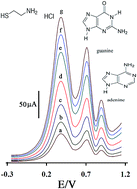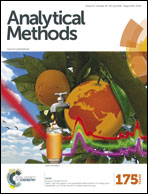Electrochemical determination of cysteamine in the presence of guanine and adenine using a carbon paste electrode modified with N-(4-hydroxyphenyl)-3,5-dinitrobenzamide and magnesium oxide nanoparticles
Abstract
Cysteamine (CA) is a high performance drug with a radiation protection effect on guanine (GA) and adenine (AD). Therefore, we focus on the preparation of a highly sensitive electrochemical sensor for determination of CA in the presence of GA and AD in biological samples. For this goal, a carbon paste electrode modified with magnesium oxide nanoparticles (MgO/NPs) and N-(4-hydroxyphenyl)-3,5-dinitrobenzamide (N-4-HP-DNBA) was fabricated. The efficiency of the proposed sensor was investigated for the electrocatalytic oxidation of CA in the presence of GA and AD for the first time. The mediated oxidation of CA at the N-4-HP-DNBA/MgO/NPs/CPE was investigated using an electrochemical approach. The electro-oxidation peak currents for CA, GA and AD were found to vary linearly with their concentrations in the range of 0.03–600 μM; 0.8–400 μM and 5.0–500 μM with detection limits of 0.009 μM, 0.4 μM and 1.0 μM, respectively. The N-4-HP-DNBA/MgO/NPs/CPE was used for the determination of CA, GA, and AD in capsule and pharmaceutical serum samples.


 Please wait while we load your content...
Please wait while we load your content...